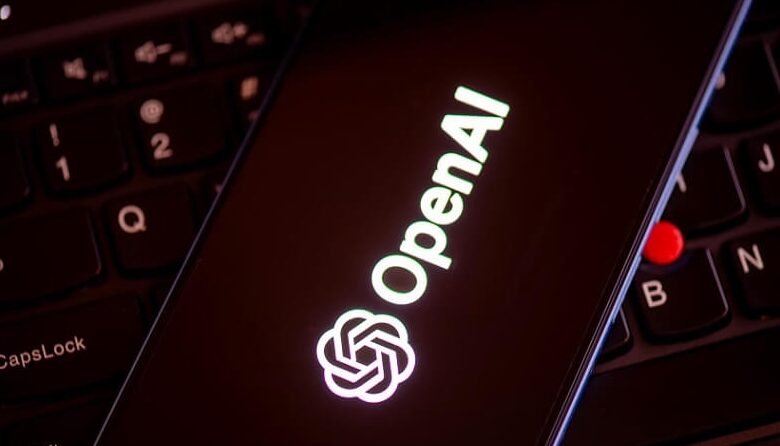Can Anyone Be a Realistic Competitor for OpenAI?

Artificial intelligence has a history dating back decades. But the release of ChatGPT in November 2022 propelled generative AI (GenAI) into the spotlight. Since then, GenAI has dominated conversations in the technology space, boardrooms, workplaces, governments, classrooms, homes — and in nearly all of those conversations, OpenAI has had a place. As a pioneer and market leader in the GenAI space, the company has been a lightning rod for hype, celebration, controversy, and criticism.
Microsoft is pouring billions into the company, and OpenAI’s valuation has been growing by leaps and bounds. On Feb. 16, The New York Times reported that the company completed a deal that values it at $80 billion or more.
Other companies, both big tech and startups, are flocking to the GenAI market. “I think we have some interesting contenders, and I think I would say the landscape is not necessarily what people would have expected five years ago,” Jerome Pesenti, former head of AI at Meta and the founder and CEO of learning app Sizzle AI, tells InformationWeek.
With the speed at which the technology is being developed and money being poured in, divining a clear picture of where we will be five years from now isn’t easy. Will OpenAI still be the big name in GenAI? Are the other companies jockeying in the space today realistic competitors, or has the competition yet to emerge?
The Potential Competition
Google’s Gemini, Meta AI, and AWS AI Services: Big tech companies are riding the wave of GenAI demand. They are creating their own models and platforms internally, as well as making investments in other companies.
Anthropic, founded by people formerly involved with OpenAI, is working to raise another $750 million in capital, pushing its valuation to approximately $18 billion, Crunchbase reports. Google and Amazon are among its investors, according to Crunchbase.
“There really is the domain of large companies who just have the resources to devote so much money into training and fine tuning,” David Guarrera, PhD, principal with EY Americas Technology Consulting, leading generative AI initiatives, tells InformationWeek.
Big tech players also have access to large consumer populations that give them an edge. “Apple has amazing access to consumers. Would that turn into go-to market vehicles for the next large model? Maybe,” says Tzahi (Zack) Weisfeld, GM and VP of Intel Ignite, an accelerator program for tech startups. “I think at this point you will need such force in order to compete, to get to similar size. You need a Google or an Apple or a Meta to get there.”
Myriad smaller startups are entering the market with GenAI-driven platforms and tools. But the billions that big tech companies have at their disposal put them ahead in the game. “I think it’s very hard for a hyperscaler today to see any startup as a competitor,” says May Habib, the CEO and co-founder of Writer, a full-stack generative AI platform, contends.
Yet, there are some interesting dynamics at play among the large companies. “People would have expected Google to be in the lead, and they’re not,” says Pesenti. “They are a little bit in a weird position right now where they’re playing catch up.”
AWS has the potential to grow its market share. “I think AWS will grow in market share because they’re using the same strategy they had to gain cloud adoption,” says Bill Wong, a principal research director leading AI and data analytics research at Info-Tech Research Group, an IT research and advisory company. He also points out that AWS is leaning into responsible AI with its Guardrails tool.
“Guardrails … allows you to monitor and to change and tweak or prevent certain prompts from being accepted and managing the responses you get back,” he explains. “That isn’t something I’ve seen from Google or OpenAI at this time.”
Microsoft released PyRIT, an open automation framework, designed to help security professionals find risks in GenAI systems.
Transparency and the ability to change the way a model behaves may be attractive for a lot of enterprises looking to leverage AI. Open-source models could be the answer.
“These are becoming more and more powerful, and they’re positioning themselves as a sort of [an] alternative to these large pay for API based models. That, I think, could really democratize the technology past just the major tech players and change the story significantly,” says Guarrera.
Llama from Meta, Mistral AI, and Hugging Face are among some of the prominent players in the open-source AI space.
“I think there’s a really interesting play around open source, and it’ll be interesting to see if it’s done through a startup or through a big tech or a combination of the two,” says Pesenti.
It is still early days for the companies competing to be the longstanding giants in AI.
“The entire generative AI market is really only two types of companies: the companies that are selling enterprises access to large language models, and then the company selling productivity panels,” says Habib. “Most of what folks actually need sits in between. They need the ability to build their own custom generative AI solutions connected to their own structured and unstructured data.”
What Could Tip the Scales
In the crowded market, what has the potential to eat away at OpenAI’s dominant position? Late in 2023, OpenAI was embroiled in leadership drama. CEO Sam Altman was ousted and reinstated within the span of a week. Most of the board members behind his firing exited the company following Altman’s return.
In a November 2023 Startup Snapshot survey focused on AI, 52% of respondents predicted that the leadership issues with Sam Altman would hamper the success of OpenAI and its products.
Could another leadership shakeup happen? Would it impact investor and customer confidence?
“The leadership drama certainly just shows you how, let’s say, how new this industry still is and how things can turn on the dime,” says Wong.
External forces also have the potential to impact GenAI market dynamics. OpenAI has been subject to numerous copyright lawsuits. Several authors brought a lawsuit against the company over its use of their books to train its large language model. A federal judge in California has dismissed several of the claims in that lawsuit, Reuters reports.
The New York Times is also among OpenAI’s copyright challengers. The publisher sued both the startup and Microsoft. The outcomes of these lawsuits have the potential to shape the way GenAI companies use copyrighted material.
In the meantime, legal challenges inject a level of uncertainty into the market. How liable are the customers using LLMs trained on copyrighted material used without permission or payment? “Google and Microsoft have publicly stated, ‘Listen, if you ever get approached by third party on a lawsuit, we’ll pay for your legal fees.’ That to me is not an answer,” Wong contends. “That is really a marketing response to try to offset people’s concerns about copyright.”
Licensing deals for content have been struck; OpenAI and the Associated Press reached an agreement. And that may be the future. For now, there are companies on both sides of the fence, some taking a better to seek forgiveness than ask permission approach and others erring on the side of caution.
“There are some companies that have just gone ahead with data that they don’t necessarily own the copyright to and some other companies that have been very conscious choice to … only train on data they have the rights to,’” Guarrera points out.
AI regulation is also a big, largely unresolved issue that could affect the way GenAI companies create and train their models and do business. “We’ve seen headbutts between OpenAI and countries like Italy who [was] the first to say, ‘Hey, do you really need all that personal data to train your model?’” says Wong.
Innovation is, as it almost always does, outpacing regulation. The EU AI Act, the first major law regulating AI, is moving forward. President Biden signed an executive order on AI last year.
While regulation is still being hashed out, enterprises are taking varied approaches to adopting AI technology and working with companies like OpenAI. Data privacy stands out as a big concern.
“We see a lot of industries staying away from even playing with like OpenAI because of the cloud-based infrastructure; data is being shared there. We saw a lot of companies restricting the use of OpenAI by their employees,” Weisfeld points out.
While lawsuits and regulation may eventually force OpenAI to pivot in some ways, the speed at which it pushes its technology forward could keep it ahead of the competition.
“If basically [it] keeps getting improvement all the way to what OpenAI calls the AGI or human level AI, then I think it’s going to be really hard to catch up with Open AI,” says Pesenti. “But if the technology starts tapering, it starts reaching a plateau, then I think that the dynamic … would be quite [different].”
If the technology hits that plateau, there could be more room for open-source players, for example.
As more real-life use cases emerge in the AI space, it is possible that customers will begin to shift away from the biggest models.
“This OpenAI scenario where you need 170 billion parameters and you need all of world history and all of the world’s geography and all of literature, all that. It’s great for general use, but there’s a need, and there’ll be more and more need for specific use cases for LLMs,” says Weisfeld. “You’re not going to need OpenAI. You’ll have smaller versions. They’ll be able to run on localized platforms and be able to run … much cheaper and in much more effective [ways].”
Wong believes that the “bigger is better” approach is ultimately unsustainable. “Eventually, you’re going to hit a wall. You’ll just run out of data to train, or at least good data,” says Wong.
“You can appeal to people’s desire to be more environmentally friendly, sustainable, if you have more fit for purpose models.”
The Long-Term Winners
There seems to be no question that AI is a transformational technology, but the spots for the long-term winners could still be up for grabs.
The AI market is still in its early days in many ways. Big tech players are focusing on building their internal models and making strategic investments. We have yet to see a wave of consolidation.
“[In] the medium- to long-term, this is going to be a transformative technology on the scale of the internet or on the scale of mobile. But even with those, you saw that sometimes we could get ahead of our skis in terms of anticipation of the time scales of these technologies,” says Guarrera. “And so … I imagine there’s going to be thinning out and a consolidation as we see a clearer path forward.”
When will we know who the long-term winners are? The answer to that question could become clearer as more use cases are proven. “I think that the bigger, more interesting question, in my opinion, is what are the GenAI-supported products that people will use every day in their [lives],” Pesenti says. “I think at the moment, not so many use cases [are] proven.”
He does point out that coding assistance stands out as a strong use case, but other use cases are likely still to emerge. “There’s been this sort of idea that there’s going to be one winner in this space, and I actually think it’s going to be more fractured and tailored to different applications and use cases,” Guarrera argues.
Enterprise customers are likely going to select different models depending on use cases they pursue. “It’s going to be a constant question about a particular use case and the trade-off between accuracy, security, latency, and cost,” Guarrera anticipates. “I think different customers who do that calculation are going to arrive at different foundational models to solve that problem.”
As more enterprises move beyond the AI experimentation phase and start making serious investments, their choices will begin to paint a clearer picture of which companies are going to be here to stay.
“I think we’re going to have to look at enterprise adoption and how that integrates with current cloud offerings and how different enterprises make their cloud and AI commitments going forward,” says Guarrera.
Models backed by big tech, open-source models, and external market factors, like regulation, are all at play. Exactly how those dynamics will ultimately shape the market is not yet certain. In the near term, Wong anticipates that OpenAI will remain a key player
“OpenAI is going to continue to be the market leader. They’re the safe choice. I don’t believe they’re going to keep that market share where it is right now, but it’ll only come down marginally,” says Wong.




